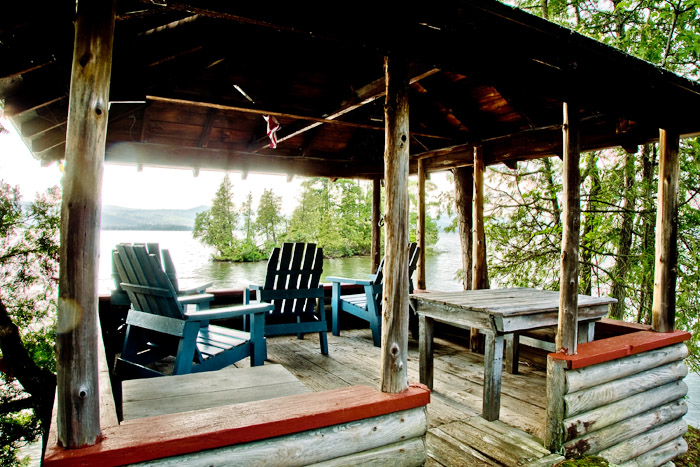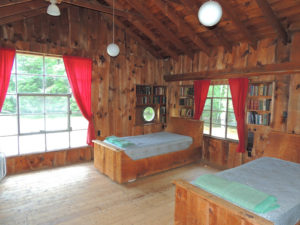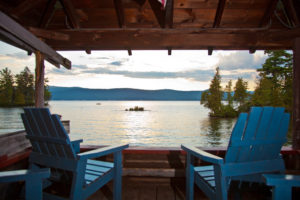By Gordon Woodworth, Chronicle News Editor
A long ago girls’ camp on the east side of Lake George that for 82 years has been an Albany family’s rustic retreat was purchased by an Ohio family on June 22 for $1.9-million cash.
Duane Vaughn of DeMarsh Real Estate represented Mr. Edwards. Ken Canastar of Select Sotheby’s International Realty represented the sellers.
The 22-acre parcel just north of Echo Bay at Pilot Knob includes 1,365 feet of lakefront, a century-old main camp overlooking a private cove, and primitive bunkhouses that the new owner Jeff Edwards says he’ll keep intact.
Mr. Edwards, in an e-mail response to The Chronicle, said he is chairman, president and CEO of the Edwards Companies in Columbus, Ohio, which he described as “a family holding company for my family’s varied residential real estate development and construction businesses.” What drew him to Lake George? “I was lucky enough to spend a few days at the Sagamore Hotel on a business outing a number of years ago, and knew then that Lake George was always some place I wanted to come back to, and spend more time chasing all of the things it has to offer.

“My wife and I have 4 active, outdoor activity loving kids and the Lake George area seems to be unparalleled in its offering of four-season activities.”
Built on an isthmus off Pilot Knob Road, the site had been home to girls’ Camp Seyon before Ten Eyck T. Mosher, Jr., purchased it in 1934, according to a written history provided by his granddaughter Margaret Wagner. (See adjacent story)
Mrs. Wagner said her grandfather was “all but bankrupt…[but] couldn’t resist the lure of stowing away in his own Adirondack camp…on Lake George. He named it ‘Rest Rock’ to commemorate the peace, restfulness and tranquility it brought to all who visited.”

The property includes a Pilot House where she says Mr. Mosher would spend hours in solitude; a bunkhouse for his three daughters; a main camp brought down from the Narrows by boat; a barn and a pumphouse.
“It’s like stepping back in time,” Mr. Vaughn said while touring the property with The Chronicle.
Mr. Edwards said, “We were looking for seclusion and privacy, but not so much so that it was either inconvenient, or impossible, to go out to dinner, grocery shop, etc.”
He added, “The fact that it has the old camp compound on an island (connected only by an eighty year old man-made isthmus to the mainland) was exactly what we were looking for in a property. The character, charm and potential that Rest Rock holds is amazing.”
He said, “We plan to renovate all of the existing structures, and if allowed add a small addition to the main house. We also plan to build a modest guesthouse on the mainland.”
He said he’ll retain the look — “very much so on the exterior, though inside there will be fairly extensive updating and redesign with modern amenities.”
According to the listing, the property is assessed at $3.27-million.
History of Rest Rock: Ten Eyck Mosher, Jr., bought it in 1934 & family enjoyed it for more than 80 years
Editor’s Note: Margaret Wagner is the granddaughter of Ten Eyck T. Mosher, Jr., who in 1934 bought property on Pilot Knob on Lake George that had been a girls camp Camp Seyon. He turned it into Rest Rock, a compound used by generations of his family for 80-plus years.
On June 22, the family sold the property to Ohio businessman Jeff Edwards for $1.9-million. The decision to sell prompted Mrs. Wagner to write a history, which she allowed us to reprint here.
She says, “Our family grieves for the loss of this magical camp but are grateful that Mr. Edwards also appreciates the unique, dreamlike nature of this special place and intends to preserve and enhance it.”
By Margaret Wagner, Special to The Chronicle
Most of us dream of possessing our own private island, a place to hide from the rigors of ordinary life and, in 1934, our grandfather Ten Eyck T. Mosher Jr., dared to purchase such a dream at the height of the depression.
All but bankrupt, Ten Eyck couldn’t resist the lure of stowing away in his own Adirondack Camp of more than twenty acres on Lake George. He named it “Rest Rock” to commemorate the peace, restfulness, and tranquility it brought to all who visited.
At first, the only building housed the kitchen with its huge, wood burning, cast iron stove and the great room with floor to ceiling book shelves, used principally as a dining hall for the girls camp that had existed there since the turn of the century. The girls slept on narrow, World War I army cots in large canvas tents rigged on wooden platforms.

There are still women in their eighties and nineties on the Lake who relish sweet memories of their girlhood summers at Camp Seyon. Marcia Noyes (Seyon is Noyes spelled backward), who ran the camp, was an internationally known medical librarian at Johns Hopkins University. Johns Hopkins provided her a penthouse apartment in Maryland and the Medical Librarians Association still gives out a yearly award in her honor.
Main camp floated from Narrows
But Miss Noyes’ summers were dedicated to the camp and her girls. Marcia had the Main House floated down from an island in the Narrows on a barge; the Camp was, then, a virtual island. A boggy path led across the isthmus to the peninsula; vehicles were left on the mainland.
My mother and father honeymooned at Rest Rock in 1935, still in this rustic circumstance.
My father placed the inscription on the massive rock fireplace that remains there to this day, “Cut your own wood it will warm you twice.” Kerosene lamps provided low, soft light in counterpoint to the dark woods and glistening lake.
By 1937, our grandfather reckoned that, with his three daughters now babies, it was time to build a bunkhouse. He had the timber cut from his own acres and milled rough sawn. Each bunkhouse room had the name of one of his daughters above the door.
The porch of the bunkhouse, hanging over the lake, he named Squealing Porch to emphasize that all crying babies be kept well away from disturbing his peace.
At the same time and from the same rough-hewn boards, he created his secret place. The tiny Pilot House sits over the water, cozy and romantic, made only of windows and bookshelves. Ten Eyck spent most days there in his hammock with his radio and books. It took special invitation to enter.
My grandmother’s best friend was an artist and, according to my grandfather, a talker. Ever valuing his tranquility, Ten Eyck thought to build her a little Studio, complete with its own stove, an encouragement that she sometimes cook for herself. Later yet, he built a master bedroom onto the main house. True to his penchant for being adrift in a boat, he had a porthole installed at the side of his bed, where he floated to the sound of lapping waves.
‘Yearned for solitude and quiet’
Ten Eyck set the tone for all that has followed. He adored his family and welcomed friends; yet he often yearned for solitude and quiet, to read a book, listen to music undisturbed in this primitive, primeval wood. He named the wood along the dirt road leading into the camp “Sherwood Forest.” As children arriving year upon year, we thrilled to the adventures that lay ahead just beyond the tumbling massive boulders that Ten Eyck called “The Cathedral.”
My cousins and I listened to Ten Eyck’s confabulated tales in wonderment. We created our own games of high adventure, shipwreck, stowaway, hiding…every cranny now a part of us.
At night, when sleep comes hard, I walk those acres in my mind. I know exactly the tilt of rock, the scent of the pine needles, the exposed roots and slippery moss on the path from the front porch of the main house to Sunset Porch, the gazebo, where the hammock awaits to lull me.
Rest Rock ‘held us together’
Life is about change, but Rest Rock is about something unwilling to do so. Bonded by Rest Rock, my cousins and I have lived connected. Could Ten Eyck have possibly foreseen how a place, Rest Rock, could hold us together? I wonder.
He created a magical circumstance, a whimsy. Over 70 years, we have come to this place of gathering and of solitude. Such different people, my cousins and our spouses; yet at Rest Rock, there is a confluence of laughter and of memory, a balance almost as ethereal as lying on your back on the dock in the dead of night looking up to the meteor showers of August, as the Milky Way streams across the sky.
Ten Eyck, his daughters and their husbands are now long dead. Our own children have children. There are seven left in my generation and sixteen in the next.
While my generation has shared so much, the generation of sixteen doesn’t know each other well. My generation is scattered across the country; this next generation, across the world.
While leading quite diverse lifestyles, the seven of us were able to act in consensus to sustain Rest Rock. Ten Eyck’s dream was sufficient to bind us. But, alas, there is just too much to hold together in a generation of cousins who are virtual strangers to one another.
This winter, with wrenching sadness, we seven had to decide to sell Rest Rock and leave our Mecca to memory.
Copyright © 2016 Lone Oak Publishing Co., Inc. All Rights Reserved.
 Glens Falls Chronicle Serving the Glens Falls/Lake George region; Warren, Washington and northern Saratoga counties since 1980
Glens Falls Chronicle Serving the Glens Falls/Lake George region; Warren, Washington and northern Saratoga counties since 1980


